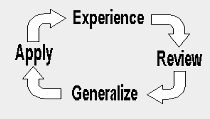Experiential Education is the process of learning through experiences, like a hands-on object lesson. Experiences can be set up or can occur naturally. However, in order to learn most effectively from the experience we must complete each step in this four part cycle:

At Connections we believe that this process is an excellent way teach principles of good character and strong relationships. All of our resources are designed to be used as an experience for learning. We hope that you may also find this method an effective and useful tool at home to help children and others learn positive lessons from any experience.
Anything can be an experience…a simple game of tag, a song that you may hear, rock climbing, or reading a book on the couch in your living room, an outing to the zoo, an argument, a child’s low test score, a toddler drawing on the wall or a fun family vacation. You could even set up an activity such as a obstacle course, reading a book, listening to a song, watching a movie or a fancy dinner as the experience to promote learning. The emotional response of any experience sets the stage for learning. An experience may include one or more participants. During activities with more than one person, find a way for each person to participate in a manner in which they feel comfortable. Even active observation is an experience.
back to top
Think about the experience, not necessarily who was involved. Analyze, evaluate and reflect about what happened to create the outcome. This might happen in your head or maybe through a conversation.
You can ask questions or use pictures or objects to help participants explain what just happened. You should ask opened ended (not yes/no) questions to help children or others explain the events that occurred and how those events affected the outcome. Using the right questions lets you lead the discussion without telling someone what they should be saying. You could ask: “What happened next?” “What happened because of (that)?” “What made (it) work?” “What made (it) more frustrating?” “What did you do to help (it) be better?” “What made the conversation turn into an argument?” “How did you act differently while using fancy dishes rather than paper plates?” Resources on this site provide some examples of questions you could ask for the specific resource
back to top
Summarize the experience. Label the skills or principles that made the experience successful or not. This step is sometimes a natural result and hard to separate from the Review step.
You can lead the group or an individual in labeling what has occurred. They will recognize patterns such as, “We communicated well.” “When we listened to each other (it) worked more smoothly.” “When we each shared ideas we were able to come up more ideas that worked.” Then you can summarize the explanations by asking, “So what did we just say?” “What skills were used?” “How would you describe what you’ve been saying in just a couple of words?” “So what made the zoo trip so fun?”
back to top
Look at how the skills used in an experience can be applied to future experiences. Plan how the new experience can be better because of the past experience. Apply that learning to real-life situations.
The questions in the application part begin with “Now What?” That leads to other questions. “How can using (that same skill) help in the future?” “Next time you face a conflict, how might listening help the situation?” “It’s hard to wash crayon off the wall. What would be a good way to not have to do that again?” “Spending time together at the zoo made you happy. So what are some ways that you can be happy in the future?” “What are some other situations you will face in school where listening can help?”
back to top
Contact us or follow us on Facebook for more information about using this process in your life and your home.
